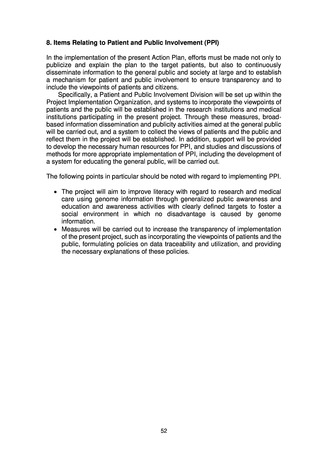よむ、つかう、まなぶ。
参考資料4_Action plan for whole genome analysis 2022 (55 ページ)
出典
| 公開元URL | https://www.mhlw.go.jp/stf/newpage_34345.html |
| 出典情報 | 厚生科学審議会 科学技術部会 全ゲノム解析等の推進に関する専門委員会(第16回 7/226)《厚生労働省》 |
ページ画像
ダウンロードした画像を利用する際は「出典情報」を明記してください。
低解像度画像をダウンロード
プレーンテキスト
資料テキストはコンピュータによる自動処理で生成されており、完全に資料と一致しない場合があります。
テキストをコピーしてご利用いただく際は資料と付け合わせてご確認ください。
10. Glossary*
Genome
The genome of an organism means all of its genetic information. Human genetic
information consists of DNA, which is an arrangement of about 3 billion bases (a
type of chemical substance) of just four types: adenine (A), guanine (G), cytosine
(C), and thymine (T).
Gene
A specific region of the genome that encodes a functional molecule such as a
protein (i.e., the base sequence of that region is converted to an amino acid
sequence). The human genome contains approximately 20,000 genes that encode
proteins. Genetic information on DNA is copied onto a substance called messenger
RNA, and proteins are made on the basis of that information.
Genomic medicine
Medical care in which a person’s genome information is analyzed to provide more
effective and efficient medical treatment that matches the patient’s physical makeup (particularly characteristics at the gene level) and medical condition.
Whole genome analysis
Analysis of the entire genome at once. In the past, it was common to narrow the
target for analysis down to a few hundred genes, but technological advances have
made it possible now to analyze the whole genome in detail. Under the
government’s Action Plan for Whole Genome Analysis, a system will be created in
which whole genome analysis is performed on samples provided by patients, and
the results are interpreted and discussed by experts so that they can be used
appropriately in the medical care of the patient. In addition, a database with genomic
and clinical information will be constructed, and this will be used as a foundation for
creating new medical treatments, pharmaceuticals, and diagnostic technologies in
the future.
Transcriptome analysis
Analysis of RNA created from the genome. RNA has a structure consisting of an
arrangement of four substances (bases): adenine (A), guanine (G), cytosine (C),
and uridine (U).
Multiomics analysis
A method of comprehensive analysis of the genome, proteins, metabolic products,
transcriptional products, etc. present in a living organism.
Sequencing
Reading the arrangement (sequence) of bases in DNA or RNA.
Sequencer
A device for reading the arrangement (sequence) of bases in DNA or RNA.
Dramatic advances in next-generation sequencers, which appeared in the mid2000s, allowed whole genome analysis at low cost using technology to read the
sequences of multiple DNA molecules simultaneously.
54
Genome
The genome of an organism means all of its genetic information. Human genetic
information consists of DNA, which is an arrangement of about 3 billion bases (a
type of chemical substance) of just four types: adenine (A), guanine (G), cytosine
(C), and thymine (T).
Gene
A specific region of the genome that encodes a functional molecule such as a
protein (i.e., the base sequence of that region is converted to an amino acid
sequence). The human genome contains approximately 20,000 genes that encode
proteins. Genetic information on DNA is copied onto a substance called messenger
RNA, and proteins are made on the basis of that information.
Genomic medicine
Medical care in which a person’s genome information is analyzed to provide more
effective and efficient medical treatment that matches the patient’s physical makeup (particularly characteristics at the gene level) and medical condition.
Whole genome analysis
Analysis of the entire genome at once. In the past, it was common to narrow the
target for analysis down to a few hundred genes, but technological advances have
made it possible now to analyze the whole genome in detail. Under the
government’s Action Plan for Whole Genome Analysis, a system will be created in
which whole genome analysis is performed on samples provided by patients, and
the results are interpreted and discussed by experts so that they can be used
appropriately in the medical care of the patient. In addition, a database with genomic
and clinical information will be constructed, and this will be used as a foundation for
creating new medical treatments, pharmaceuticals, and diagnostic technologies in
the future.
Transcriptome analysis
Analysis of RNA created from the genome. RNA has a structure consisting of an
arrangement of four substances (bases): adenine (A), guanine (G), cytosine (C),
and uridine (U).
Multiomics analysis
A method of comprehensive analysis of the genome, proteins, metabolic products,
transcriptional products, etc. present in a living organism.
Sequencing
Reading the arrangement (sequence) of bases in DNA or RNA.
Sequencer
A device for reading the arrangement (sequence) of bases in DNA or RNA.
Dramatic advances in next-generation sequencers, which appeared in the mid2000s, allowed whole genome analysis at low cost using technology to read the
sequences of multiple DNA molecules simultaneously.
54

























































